TREATMENT FOR BACK PAIN AND HERNIATED DISCS
Causes and symptoms | Treatment | Consultations and second opinions
Dr Alessandro Rustia (I) is a highly-trained specialist in spinal surgery and pain management and has many years of professional experience with the entire neurosurgical spectrum, injuries and degenerative diseases of the spine.
We ensure rapid, expert assessment and consultation as well as treatment in line with the latest medical findings. Call us or book a consultation.
FUNCTIONALITY OF THE SPINE
The spine is the supporting element of the skeletal system. It enables upright posture and connects the other parts of the skeleton. The sensitive spinal cord is located within the vertebral canal of the spinal column. Because of this, spinal surgery requires extreme precision and an experienced spinal surgeon.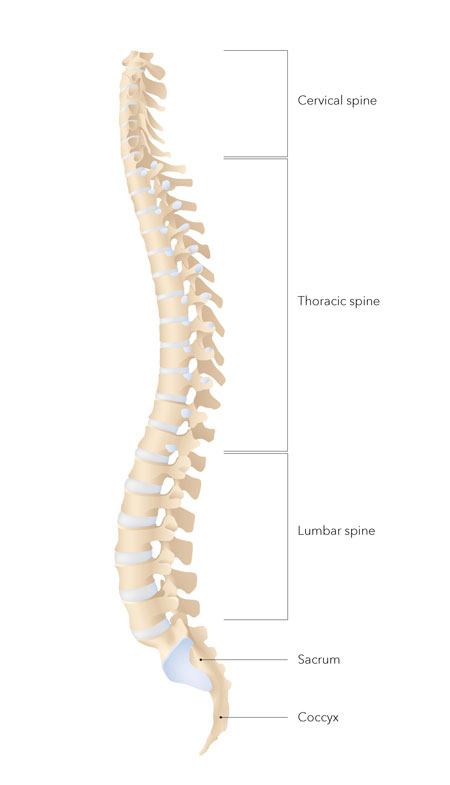
Back pain is a common condition that affects around 70 per cent of people. It can have many causes. Chronic stress on the spine due to sedentary activities such as office work, and too little movement are often the main reasons for pain. Both are often not sufficiently compensated during leisure time, so back pain can be the result.
Over 80 per cent of the population in Western industrialised countries are estimated to suffer from spinal pain at least once in their lives and require medical treatment for this reason. Spinal pain can be caused by various factors including congenital, hereditary, inflammatory or degenerative spinal conditions.
Herniated discs in the cervical and lumbar spine can be very painful.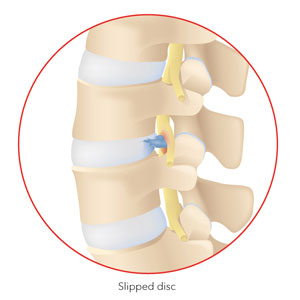
In a herniated disc in the cervical spine, after tearing a disc, a piece of the disc nucleus presses on a spinal nerve or the spinal cord. Typical symptoms are severe pain in the neck radiating into the arm or even the fingers. Neurological symptoms may also occur: sensory disturbances, numbness, tingling, and weakness of the arm or hand. If a prolapsed disc presses on a nerve root in the lower lumbar spine, there is usually a sudden pain that radiates into the leg. This pain may be accompanied by sensory disturbances or paralysis.
Spinal stenosis is the partial or complete narrowing of the spinal canal.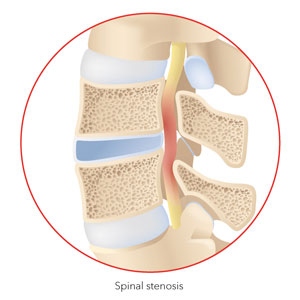
It occurs most frequently in the lumbar or cervical spine as a result of degenerative changes. Changes in the ligaments (hypertrophy), protrusions of the intervertebral discs and displacement of the vertebrae in relation to each other with instability of the intervertebral disc space can be observed.
Spondylolisthesis is a medical term for instability of the spine.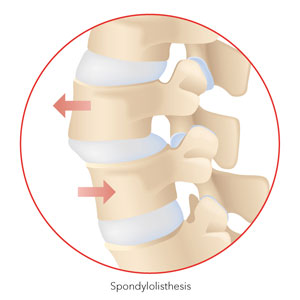
The lumbar spine is often affected. There are many different causes of spondylolisthesis. It usually relates to wear on the spine and occurs in two to four per cent of the population. Competitive athletes are more likely to be affected. People with spondylolisthesis experience stress- or movement-dependent lower back pain, combined with radiation of the pain into the legs. Sensory disturbances, paralysis and shortening of pain-free walking distances may also occur.
A vertebral body fracture often occurs as a result of sudden force, such as a sporting or car accident.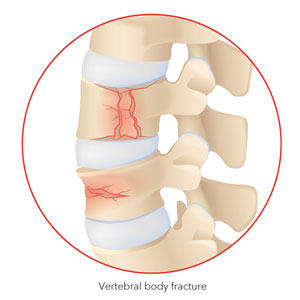
If the bone structure is already damaged, for example, due to osteoporosis, rheumatism or cancer, a vertebra that has become less stable as a result of a wide variety of causes can fracture even without external impact. This damage is called a vertebral body compression fracture. The fracture usually causes pronounced and sudden back pain and can range from pain that radiates into the legs to paralysis. If a vertebral body fracture is already present, the risk of another fracture is significantly increased. Appropriate treatment of both the cause and the fractured vertebra are therefore very important.
The most common causes in younger people and in physically demanding occupations are overloading of the muscles and soft tissues and poor static posture.
They usually cause pain but tend to disappear quickly even if untreated. Bad posture often causes tension in the muscles.
Due to the overloading, the muscles lose their normal extensibility, harden and become painful. These problems are often triggered by bad posture in the neck and shoulder area. The tension in the upper spine then continues downward.
In particular, people without neurological deficit symptoms, with onset of symptoms within six months and without previous regular physiotherapy can be treated conservatively very well.
Conservative treatment options:
- Anti-inflammatory medications and painkillers
- Medical training therapy/physiotherapy, back school, posture correction, spinal stretches
- Changes in lifestyle including sports, tackling obesity, diet, etc.
- Pain management, including injections in the small vertebral joints (facet joints) of the spine
- Radiofrequency treatment of the spine
- Complex investigations of the spine
SURGICAL TREATMENT
Depending on the extent of the symptoms, there are various treatments available. It is important to have a thorough examination and consultation with a specialist, who can evaluate all the treatment options.
If the options for conservative treatment are exhausted and:
- quality of life is severely restricted as a result,
- neurological deficits/paralysis such as monoparesis, paraparesis, tetraparesis are present,
- unacceptable treatment-resistant pain negatively affects life
- or the risk of paralysis is increased with conservative treatment,
surgical treatment should be considered.
In the case of a herniated disc with persistent severe pain, adequate findings and consistently applied conservative therapy, and no improvement or worsening of the clinical symptoms within a period of six to twelve weeks, an assessment for a surgical procedure should be undertaken in order to prevent chronic pain.
Overview of surgical treatment options available:
- For spinal fractures (due to reduced bone density or functional weakness of the spine): minor surgical procedure (kyphoplasty), surgery of the entire spine with or without cement
- Treatment of herniated discs with radiofrequency ablation
- Surgical techniques under a microscope (microsurgical) as well as state-of-the-art surgical (minimally invasive) procedures with the least possible injury to tissue
- Artificial replacement of intervertebral discs with prostheses in the cervical and lumbar spine for better mobility, without putting excess strain on other discs
- Stabilising procedures for tumours of the spine
- and for degenerative diseases of the entire spine (herniated discs, instability, spinal stenosis and inflammation in all sections of the spine)
- For chronic persistent nerve pain: Neurostimulation
- Follow-up, revision or corrective surgery
Dr Alessandro Rustia (I) has many years of experience and is highly skilled in spinal surgery and pain management. We ensure rapid, expert assessment and consultation as well as treatment in line with the latest medical findings. Don’t hesitate to get in touch if you would like a second opinion.
Because the Pyramid Clinic is a private clinic, patients here require supplementary insurance. You will therefore need private or semi-private insurance for your treatment. If you have general insurance you can also be treated here if you opt to pay for an upgrade.